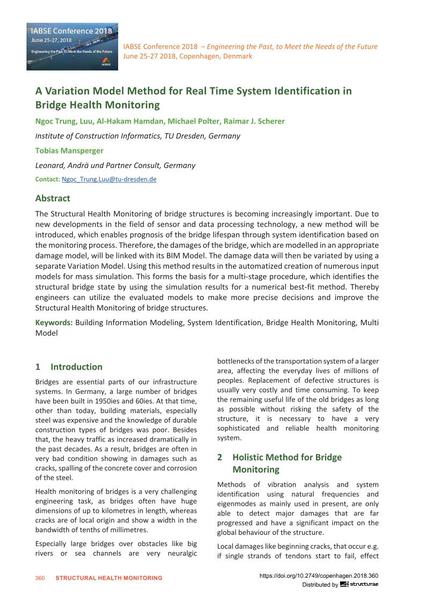A Variation Model Method for Real Time System Identification in Bridge Health Monitoring

|
|
|||||||||||
Détails bibliographiques
| Auteur(s): |
Ngoc Trung
(Institute of Construction Informatics, TU Dresden, Germany)
Luu (Institute of Construction Informatics, TU Dresden, Germany) Al‐Hakam Hamdan (Institute of Construction Informatics, TU Dresden, Germany) Michael Polter (Institute of Construction Informatics, TU Dresden, Germany) Raimar J. Scherer (Institute of Construction Informatics, TU Dresden, Germany) Tobias Mansperger (Leonard, Andrä und Partner Consult, Germany) |
||||
|---|---|---|---|---|---|
| Médium: | papier de conférence | ||||
| Langue(s): | anglais | ||||
| Conférence: | IABSE Conference: Engineering the Past, to Meet the Needs of the Future, Copenhagen, Denmark, 25-27 June 2018 | ||||
| Publié dans: | IABSE Conference Copenhagen 2018 | ||||
|
|||||
| Page(s): | 360-366 | ||||
| Nombre total de pages (du PDF): | 7 | ||||
| DOI: | 10.2749/copenhagen.2018.360 | ||||
| Abstrait: | The Structural Health Monitoring of bridge structures is becoming increasingly important. Due to new developments in the field of sensor and data processing technology, a new method will be introduced, which enables prognosis of the bridge lifespan through system identification based on the monitoring process. Therefore, the damages of the bridge, which are modelled in an appropriate damage model, will be linked with its BIM Model. The damage data will then be variated by using a separate Variation Model. Using this method results in the automatized creation of numerous input models for mass simulation. This forms the basis for a multi‐stage procedure, which identifies the structural bridge state by using the simulation results for a numerical best‐fit method. Thereby engineers can utilize the evaluated models to make more precise decisions and improve the Structural Health Monitoring of bridge structures. | ||||
| Mots-clé: |
Building Information Modeling
|
||||
